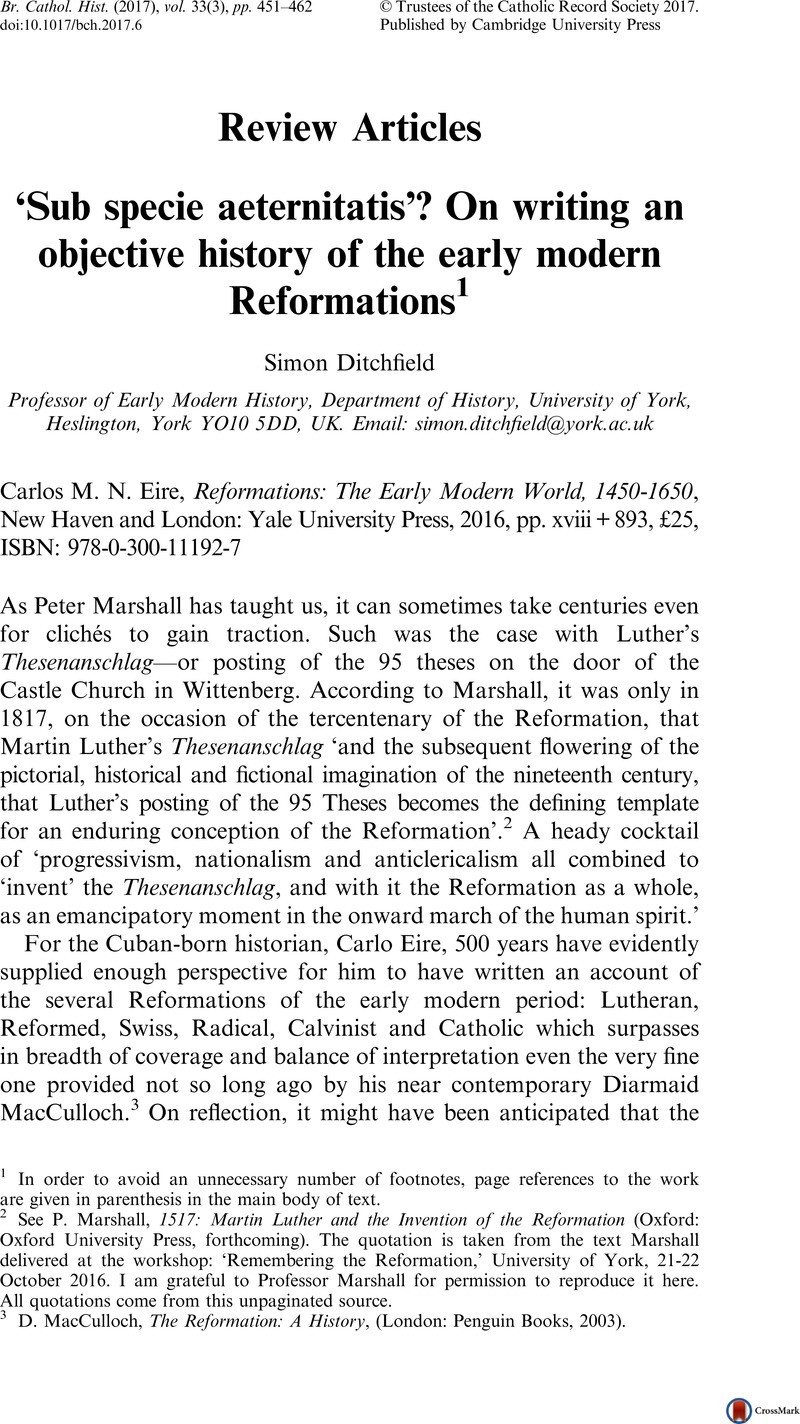No CrossRef data available.
Article contents
‘Sub specie aeternitatis’? On writing an objective history of the early modern Reformations1
Review products
Published online by Cambridge University Press: 30 March 2017
Abstract

- Type
- Review Articles
- Information
- Copyright
- © Trustees of the Catholic Record Society 2017. Published by Cambridge University Press
Footnotes
In order to avoid an unnecessary number of footnotes, page references to the work are given in parenthesis in the main body of text.
References
2 See Marshall, P., 1517: Martin Luther and the Invention of the Reformation (Oxford: Oxford University Press, forthcoming)Google Scholar. The quotation is taken from the text Marshall delivered at the workshop: ‘Remembering the Reformation,’ University of York, 21-22 October 2016. I am grateful to Professor Marshall for permission to reproduce it here. All quotations come from this unpaginated source.
3 MacCulloch, D., The Reformation: A History, (London: Penguin Books, 2003)Google Scholar.
4 War Against the Idols: The Reformation of Worship from Erasmus to Calvin (Cambridge: Cambridge University Press, 1989); From Madrid to Purgatory: The Art and Craft of Dying in Sixteenth-Century Spain, (Cambridge: Cambridge University Press, 1995); A Very Brief History of Eternity, (Princeton: Princeton University Press, 2010).
5 Eire, A Very Brief History of Eternity, 16-17. For a moving account of the author’s Cuban childhood see his prize-winning memoir: Waiting for Snow in Havana: Confessions of a Cuban Boyhood, (New York: Free Press, 2003) and the sequel: Learning to Die in Miami: Confessions of a Refugee Boy (New York: Free Press, 2010).
6 http://www.pedropan.org/category/history (last accessed 30 January 2017).
7 ‘Introduction’ to Emily Michelson, Scott K. Taylor & Mary Noll Venables eds. A Linking of Heaven and Earth: Studies in Religious and Cultural History in Honour of Carlos M. N. Eire (Farnham:Ashgate, 2012), 1.
8 In (not only) this respect, Eire is close to Brad Gregory’s unapologetically apologetical approach to the writing and interpretation of Christian history as reflected in the latter’s robustly argued: The Unintended Reformation: how a religious revolution secularised society, (Cambridge MA/London, 2012). Cfr. B. Gregory, J. Coffey & A. Chapman eds., Seeing things their way: intellectual history and the return of religion, (Notre Dame, 2009).
9 For a fuller explanation of the changes in canonization procedure for the period see: Ditchfield, Simon, ‘Tridentine worship and the Cult of saints’ in R. Po-chia Hsia ed., The Cambridge History of Christianity. Vol. VI. Reform and Expansion, 1500-1660, (Cambridge: Cambridge University Press 2007), 201-224 Google Scholar. It should also be noted that it was Roberto Bellarmino, not as Eire has it (402) Carlo Borromeo, who questioned the wisdom of Heribert Rosweyde’s plan for what became the Acta sanctorum on the grounds that such a comprehensive collection of saints’ lives would just provide ammunition for Protestant controversialists to use against the Catholic Church.
10 An argument which I have outlined in my chapter ‘Catholic Reformation and Renewal’ in Marshall, P. ed., The Oxford Illustrated History of the Reformation, (Oxford: Oxford University Press, 2015), 152-185 Google Scholar and which I will be developing more fully in my forthcoming survey: Papacy and Peoples: the making of Roman Catholicism as a World Religion, 1500-1700.




